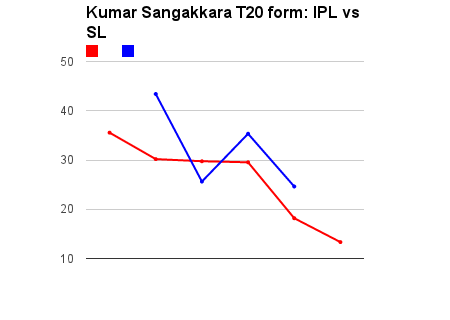The current IPL has raised the notion of whether Kumar Sangakkara is as good a T20 batsman as his stature and his record suggests. He averages just over 30 in Internationals and 28.13 in domestic cricket (IPL included. Is this is so far removed from what one would have expected from one of the finest and most prolific batsmen the game as ever seen? Certainly if you watch him play when he is in form, you would have said that Twenty20 as a format would be just another notch on his bedpost. The 30 or so runs that he will score (on average) will tend to be thirty of the most beautifully played runs you could wish to see, but there is the argument someone one his stature and of the price that he inevitably demands from a Twenty20 franchise dictates that he should contribute more with the bat. He actually started his IPL career rather well, with scores of 54, 94, 50 and a 64 in IPL 1 whilst playing with the Kings XI Punjab. He scored 320 runs in that series (9 innings) at 35.55. This then dropped to 30.18 in IPL2 (13 innings) and 29.75 in 2010 (12 innings) and things kind of steadily go downhill from there.

Graph comparing Sanga’s IPL form (red line) with his SL form (blue line). (Note: Sanga didn’t play any T20s for SL in 2008 and 2013 thus far).
Sanga’s IPL form has for the most part been eclipsed by his Sri Lanka form. This coincided with a relatively successful time of it as Sri Lanka captain, and also benefiting from playing in a settled team at a settled batting position around players he is familiar with. Generally speaking he would come in after Mahela and Dilshan had set the tone at the top of the order, thus allowing him to just dictate the tempo from there on end. A lot of the times that I have seen him in the IPL, he tends to get frustrated if he is not allowed to dictate the tempo and plays or mistimes a shot that leads to him getting out. In his entire IPL career, 66% of his dismissals have ended with him being caught out (not including innings where he has finished not out). This is perhaps true of a lot of players of his standard. You can not going to miss many deliveries, and many a medium-paced trundler has had his bowling statistics beefed up by the amount of times he gets batsmen out caught on the boundary. Mahela has a caught out percentage of 62%, Dhoni 74%, Sachin 56% whilst Suresh Raina’s dismissals are 81% likely to be caught. This doesn’t really say much as a batsman is more likely to be caught out than any other dismissal, even more so in Twenty20 cricket. I would perhaps suggest that judging a player by his IPL form is not the right barometer. It should be taken into account of course but International T20 is surely the best way to determine the quality of an international player? The quality is higher and you are playing on different types of pitches instead of the flat ones generally found in India.
By comparing Sangakkara’s batting average and strike-rate with the best in the business (minimum of 30 Twenty20 Internationals), you can see that whilst he on average only two or three runs short of being among the most successful. However, his strike-rate is the one that sets him apart from the rest. 120.94 is just not quick enough, and certainly his delivery usage is something that has been criticized in this IPL and bygone years. But he has always been someone to play himself in first regardless of the state of the match and then look to bat according to the situation. It is a trait that I have admired, but can be quite annoying in a crisis when all you want is for him to deposit one over long-on. I would argue that his willingness to play himself in is part of what makes him one of the best Test batsmen ever. If you take the averages of those who can hold a candle to his Test average and who have also played more than 10 T20 Internationals, their T20I strike-rates aren’t particularly great either. Ricky Ponting’s SR is 132.78, Jacques Kallis’ is 119.35, Michael Clarke’s is 103.17 and Sachin Tendulkar’s is 83.33.
He has become an easy target in the IPL. Pinning the blame for last season’s Deccan debacle at his feet isn’t on, as Deccan didn’t have a single pace bowler that could back Steyn up and Amit Mishra was very expensive. His lack of runs didn’t help of course, but that set up was always destined to struggle in the IPL. So with all that in mind, if what makes Sanga’s T20 strike rate so poor also makes him such a dominant Test batsman, then I wouldn’t change a thing. I’d certainly wouldn’t go forcing him to change his game and I get the feeling he is comfortable with it. He still is part of the reason Sri Lanka are a good T20 side and that is all that matters to me, really.


